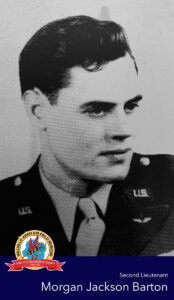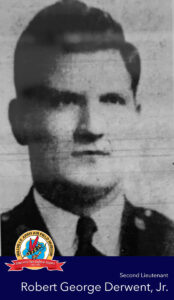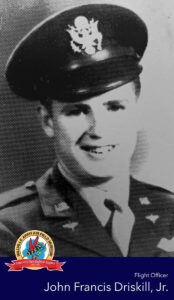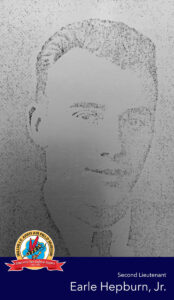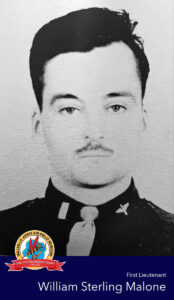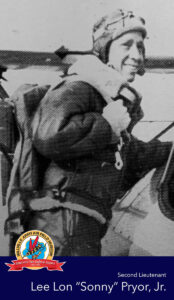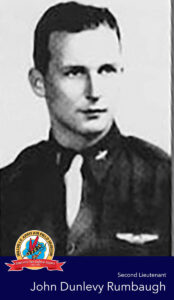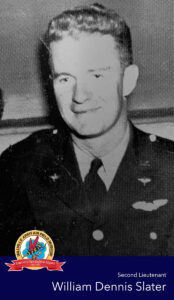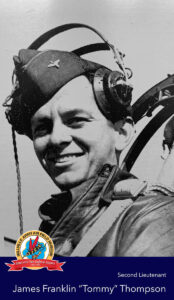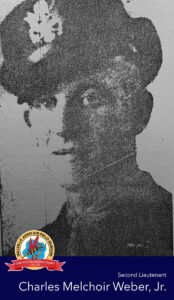Special thanks to Anthony DiStefano, MAAF Museum Volunteer, for your valuable and informative research on our fallen pilots.
Second Lieutenant Morgan Jackson Barton
2nd Lt. Barton, serial number O-728545, was born December 6, 1917, in Greybull, Wyoming, and was a resident of Sheridan, Wyoming for most of his life. He graduated from Sheridan High School in 1936. Attending Hastings College in Hastings, Nebraska he studied music, won multiple medals for track taking 1st place in the mile and two-mile races. Jack was also a member of Delta Phi Sigma fraternity and the H-Club. At Hastings he had a reputation for being a prankster, a great friend, and his love for academics, but most importantly he had a wonderful moral foundation. Four years after entering Hastings College he graduated.
A week after the attack on Pearl Harbor he entered the Army Air Corps on December 13, 1941. He received his training as a fighter pilot at Luke Field, Arizona where he received his silver wings and was commissioned a Second Lieutenant on August 27, 1942. He received other training in California, New Hampshire, and New Jersey. He married Miriam Lola Samelson on 30 December 1942 in Sheridan, Wyoming.
At Millville, New Jersey, he was assigned to the 352nd Fighter Squadron of the 353rd Fighter Group for the final phase of pilot gunnery training. At 9 a.m. on April 17, 1943, piloting a P-47D Thunderbolt (serial number 42-22340) on an instrument training mission, he went into an uncontrollable spin when at about 3000 feet his aircraft went into a steep dive into Barnegat Bay, near Sea Bay, New Jersey crashing into only 4 feet of water about 300 yards from shore.
The first fatal P-47 pilot accident from the Millville Army Air Field, 2nd Lt. Jack Barton was Twenty-five years old. Miriam, his 19 years old wife who was living in Millville, found out she was pregnant that same day. Devastated, the trajectory of their family lives was completely altered. Their daughter born 9 months later grew up never knowing her father.
The “Apple of his Mother’s eye”, Jack’s family described him as the most lively, fun-loving, well-liked fellow who would light up a room and had a great sense of humor. He expressed to his family that he wanted to be a minister after he returned from military duty.
Miriam eventually remarried; interesting, her mother-in-law who owned a house at Tom’s River witnessed the crashed that killed Lt. Barton. The irony of Lt. Morgan Jack Barton’s daughter’s step-grandmother seeing the tragic crash has not been lost on the family.
Second Lieutenant William Engle Canniff, Jr.
 2nd Lt. Canniff, serial number O-835959, was from Englewood, New Jersey. He was born in Cincinnati, Ohio, on May 22, 1920. As a boy, Bill dreamed of becoming a pilot and had pinned pictures of pilots on his bedroom walls. After graduating from Dwight Morrow High School in Englewood, New Jersey, he attended Dartmouth College in Hanover, New Hampshire where he ran cross country. William graduated Dartmouth Class of 1941. When he went to enlist in the Army Air Corps he initially did not pass the dexterity test due to a finger deformity. With great determination, he practiced picking up straight pins for hours each day for several months. He passed the test and his lifelong dream was fulfilled when he enlisted in the Army Air Corps in early 1944.
2nd Lt. Canniff, serial number O-835959, was from Englewood, New Jersey. He was born in Cincinnati, Ohio, on May 22, 1920. As a boy, Bill dreamed of becoming a pilot and had pinned pictures of pilots on his bedroom walls. After graduating from Dwight Morrow High School in Englewood, New Jersey, he attended Dartmouth College in Hanover, New Hampshire where he ran cross country. William graduated Dartmouth Class of 1941. When he went to enlist in the Army Air Corps he initially did not pass the dexterity test due to a finger deformity. With great determination, he practiced picking up straight pins for hours each day for several months. He passed the test and his lifelong dream was fulfilled when he enlisted in the Army Air Corps in early 1944.
He received his primary training at Jackson, Mississippi. In March he went to Walnut Ridge, Arkansas, for basic training. May of 1944 he received his advanced training at Napier Field, Alabama where he received his silver wings and was commissioned a Second Lieutenant on August 4, 1944.
Second Lieutenant Canniff had been assigned to the 135th Fighter Squadron for pilot advance gunnery training at Millville Army Air Field, NJ. On the afternoon of May 14, 1945, he was piloting a P-47D-23 Thunderbolt (serial number 42-27826) on a chemical smoke training mission over the Delaware Bay. The flight leader changed the formation while Second Lt. Canniff was positioned last of the four P-47 aircraft in the formation. As a result of the formation change at a low altitude, his Thunderbolt had struck the water, broke up, and submerged immediately into the Delaware Bay. No one witnessed the crash that happened approximately 2-1/2 miles southwest of the mouth of the Cohansey Creek. The other pilots only observed a circle of smoke and his aircraft upside down before it disappeared below the surface. Another P-47 remained on the scene until relieved by a Navy PBY aircraft. Boats were dispatched to the scene, but his body was never found and his aircraft never recovered.
His younger sister Suzanna answered the knock at the door when the Army came to tell the family of the accident. Second Lieutenant William Engle Canniff, Jr., was just a week away from his 25th birthday.
Captain Harold Hedley “Red” Crossley
Captain Crossley, O-789304, was born in East Templeton, Massachusetts, on May 6, 1917. Growing up in Gardner, MA he was the youngest boy in a family of eight. At Gardner High School he was named “The Best Athlete” in 1935. College prep was at Cushing Academy in Ashburnham where he was a three-letter athlete and a high-scoring quarterback. After graduating Cushing Academy, he entered the University of Vermont majoring in Electrical Engineering where he played football, basketball, baseball, and inter-fraternity athletics. Harold Crossley was also a member of the Gold Key National Honor Society for his Junior and Senior Years at the University. Red Crossley left the university in his senior year to enlist in the Army Air Corps as an Aviation Cadet on September 4, 1941 from Boston, Massachusetts.
Harold Crossley received his Primary Training at Dorr Field, Arcadia, Florida from Oct-Dec 1941. He arrived at Shaw Field, Sumter, South Carolina on December 12, 1941 for Basic Training. After completing Basic, he then transferred to Spence Field, Moultrie, Georgia on 19 February 1942 for Advance Training where he received his silver wings and commissioned a Second Lieutenant on April 29, 1942. Following graduation, he joined the 65th Pursuit Squadron in Boston, MA transitioning to P-40 Warhawks.
Between assignments he married Christina Howcrouft in September 1942.
Promoted to First Lieutenant January 1943, he then shipped out to North Africa arriving in January 1943. Piloting the P-40F Warhawk in combat over North Africa and the Southern Europe-Tunisia-Sicilian area, Captain Crossley shot down two ME-109 Messerschmitts with one more probable and damaging three. He is also credited with destroying two more on the ground.
On September 7, 1943, flying a fighter sweep on his last mission, his group was heading back to home base when they came across four barges and a sea-going tug. Not wanting to miss an opportunity, Captain Crossley led his group in an astern attack on the vessels. What he didn’t realize was that the Germans had set up the four barges for their target practice. As the Warhawks were attacking the vessels, the Germans opened up on the fighter group. All vessels were sunk without a single loss to the group. When they landed at base, his P-40 was so shot up it had to be scrapped.
After completing 60 combat missions, and attaining the rank of Captain on June 1943, he was sent back to the States. After he transitioned to the P-47 Thunderbolt, Captain Crossley arrived at Millville Army Air Field in February 1944 as an Advanced Gunnery Instructor.
On April 2, 1944, shortly before noon Captain Crossley was leading a flight of four on an advance gunnery mission. Piloting a P-47D-2 (serial number 42-22553) when his Thunderbolt suddenly caught fire and crashed in the Atlantic Ocean 10 miles off the coast of Atlantic City, New Jersey.
Captain Harold Hedley “Red” Crossley, his father’s “Pride and Joy” was just age 26 at the time of his fatal accident, had been a flight instructor for 2-months and was a seasoned veteran. His awards include the Distinguished Flying Cross, Air Medal with twelve oak leaf clusters, Air Force Citation of Honor, and the Europe-Africa-Middle East (EAME) Campaign Ribbon with three battle stars.
Second Lieutenant Robert George Derwent, Jr.
2nd Lt. Derwent, serial number O-816063, was born December 18, 1922, in New York City, New York, and was living in White Horse, Trenton, New Jersey, when he entered the United States Army Air Corps as an aviation cadet on February 8, 1943. He attended Central High School and graduated from Trenton Catholic Boys School. After graduation from high school, he then attended Bordentown Military Institute (BMI), Bordentown, New Jersey where his course of study was College Preparatory. Known as “Red” at BMI, he played varsity football and was an All-State point guard. He was also known for his corny jokes and great smile. Robert was a graduate of BMI, Class of 1942 with a with a rank of Private First Class. After BMI he worked at John Roebling & Sons in Trenton, New Jersey.
Second Lieutenant Robert George Derwent, Jr. received his silver pilot’s wings and was commissioned a Second Lieutenant on November 3, 1943 at Spence Field, Georgia.
Stationed at the Millville Army Air Field, Millville, New Jersey in November 1943, he was assigned to the 536th Fighter Squadron, 87th Fighter Group for pilot advanced gunnery training. On February 8, 1944, while on an aerial gunnery mission, 2nd Lt. Derwent was number three aircraft of four. His takeoff was normal until about 300 feet when his P-47D Thunderbolt (serial number 42-22264) made a flat turn to the left, spun in, crashed and burned a quarter mile off the runway behind Reich Farm on Cedarville Road. An inspection of the wreckage revealed the propeller governor linkage had malfunctioned, causing a sudden change in propeller pitch that caused the fatal crash.
He was the youngest of the fourteen P-47 pilots killed at the Millville Army Air Field. His fatal accident happened exactly one year from his enlistment. Second Lieutenant Robert George Derwent, Jr. had only recently celebrated his 21st birthday prior to his fatal accident. He was the only child of Robert Derwent and Nora McCarthy, however; he did have two step-brothers through his mother.
Flight Officer John Francis Driskill, Jr.
F.O. Driskill, T-124801, was born June 24, 1922 in Van Horn, Iowa and moved to Lone Rock, Wisconsin as a child. John graduated from Richland Center High School in 1940 then went to work at the Forest City Knitting Company before enlisting in the Army on November 12, 1942.
He went to basic training at Camp Robinson, Arkansas and was later accepted as an aviation cadet. He received basic, primary, and advanced flight training at fields located in Oklahoma and Texas. On February 8, 1944, F.O. Driskill received his silver wings and was sworn in as a Flight Officer at Aloe Field, Texas. He was then sent to Camp Springs, Maryland for P-47 transition training and on to Millville Army Air Field, Millville, New Jersey for P-47 pilot advance gunnery training with the 537th Fighter Squadron.
On July 26, 1944 on what was to be his last training flight before graduation the next day, F.O. Driskill took off in his P-47D-2 (serial number 42-8220) a little past 8 p.m. The training mission was for a night four-ship formation and navigational training. Climbing to 8,000 feet they flew over Philadelphia and then Trenton. Shortly after 9 p.m. F.O. Driskill’s P-47 dropped down and away from the formation. He then started back into position. The number three position aircraft asked him if he was having any problems and to go on instruments if he lost sight of the formation or horizon. There was no acknowledgement from F.O. Driskill. Witnesses on the ground heard his engine develop trouble. His Thunderbolt rolled then went into a steep dive, impacted the ground and exploded on Pete May’s farm located on the White Horse and Hamilton Roads, about 5 miles Southeast of Trenton, New Jersey. The fatal crash left a 20-foot diameter and 11-foot-deep hole in the ground.
Flight Officer John Francis Driskill, Jr. had just turned 22 years old when he died. Forty years after his death, the city of Millville and the Millville Executive Airport named Driskill Street to honor his memory.
Second Lieutenant Andrew Jackson “AJ” Easterwood, Jr.
 2nd Lt. Easterwood, O-823046, was born April 4, 1923, in Tallapoosa County, Alabama, and was three years old when his family moved to Dadeville, Alabama. After graduating from Tallapoosa County High School May 1941, he entered Alabama Polytechnic Institute, now Auburn University, in the fall to pursue a career in Aeronautical Engineering. During the summer of 1942, AJ was worked for E.I. Du Pont Nemours & Co. in their production department.
2nd Lt. Easterwood, O-823046, was born April 4, 1923, in Tallapoosa County, Alabama, and was three years old when his family moved to Dadeville, Alabama. After graduating from Tallapoosa County High School May 1941, he entered Alabama Polytechnic Institute, now Auburn University, in the fall to pursue a career in Aeronautical Engineering. During the summer of 1942, AJ was worked for E.I. Du Pont Nemours & Co. in their production department.
On October 19, 1942, he enlisted in the Army Air Corps and reported for active duty on February 1, 1943. He attended training at Technical School Special Training Unit in Miami Beach, Florida, and Tennessee Polytechnic Institute Training Center in Cookville, Tennessee, where he was classified for pilot training.
His cadet training was in the Army Air Corps Southeast Training Command; preflight was at Maxwell Field in Montgomery, Alabama. He soloed in primary training at Decatur, Alabama. Basic training was at Courtland Army Airfield in Courtland, Alabama, where he was introduced to formation and night flying. Advanced training took place at Craig Field in Selma, Alabama. He graduated in Class 44-A on February 8, 1944, receiving his silver wings and commission as a Second Lieutenant at the age of 20. Following graduation, he traveled home for his first leave.
Despite recommendations for combat training, 2nd Lt. Easterwood was selected as an instructor pilot and transferred to the Central Instructors School at Randolph Field, Texas. Completing Instructor School, he returned to Courtland as an instructor before being accepted for combat training. Training in P-40s took him back to Craig Field, and gunnery at Eglin Field, Florida. He was then assigned to the Pilot Replacement Pool at Richmond Army Air Base, Virginia. Then he was transferred to Camp Springs Army Air Base in Washington, D.C. to fly the A-24 Dive Bomber and the P-47 Thunderbolt. From Camp Springs he reported to the Millville Army Air Field, Millville, New Jersey, to the 536th Fighter Squadron in early September 1944 for Advance Gunnery Training in the P-47.
2nd Lt. Easterwood’s dream to become a fighter pilot was snuffed out just before noon of September 23, 1944, only two weeks after reporting and on his eighth flight at Millville. He took off as the number three in a flight of four on an aerial gunnery mission. While firing on a tow target off the coast of Townsend’s Inlet, his P47C (serial number 41-6498) apparently struck the tow target cable separating it from the tow craft. No one witnessed his aircraft hitting the tow target and only a Naval pilot stationed at Wildwood saw his aircraft strike the water but did not see a parachute nor pilot. Crashing into the Atlantic Ocean seven miles from shore off the Cape May Naval Station in Cape May, New Jersey, neither he nor his P-47 were recovered.
AJ was remembered by his family and friends for his excellent scholastic work, how positive he was about life when just talking to him, and what a good influence he had on others. A close friend said AJ would make the best of any situation and would always come up with a grin. Forty years after his death, he was still missed by his family who continued to maintain a vacant chair in his memory. A memory of how much he loved his family, home and country.
He was known as an exceptional pilot, capable officer, and a perfect gentleman by his Squadron mates, officers, and men.
Forty years following his death, the City of Millville named Easterwood Street at the Millville Executive Airport in his memory.
Second Lieutenant Earle Hepburn, Jr.
2nd Lt. Hepburn, O-715538, was born in Marion Station, Pennsylvania, on April 25, 1919. He was a track and basketball star at Episcopal Academy and the University of Pennsylvania. Earle had his pilot’s license before the age of 20. A University of Pennsylvania graduate class of 1941 he studied law and was a member of Sigma Alpha Epsilon fraternity.
Passing the Army’s mental test, he was notified he would be called only for a non-combat role because of complications he had from an old operation so he was rejected for the Army Air Corps. Desperately wanting to fight for his country as a U.S. Army Air Force pilot, he decided to undergo a dangerous surgery despite the advice of two surgeons who said the surgery could be fatal. Undeterred he underwent the surgery in September 1942. He survived the surgery and enlisted in the Army Air Corps on February 1, 1943. On March 12, 1944 he earned his silver wings and was commissioned a Second Lieutenant at Foster Field, Texas. At Millville Army Air Field for advance pilot gunnery training, Earle had a short break in his training with the 537th squadron that enabled him to get married to the woman he had serenaded while in college. Loisjeanne Axelson and 2nd Lt. Earle Hepburn Jr were wed on May 12, 1944 in Philadelphia, Pennsylvania.
Tragedy struck on July 12, 1944 as Lt. Hepburn’s P-47D (serial number 42-75500) Thunderbolt crashed short of the runway. Approaching the runway with the tow-target still attached, the engine cut out and backfired as the P-47 rolled over on its back and dove into the ground from about 400 feet. His wife and In-Laws watched the fatal accident from the Millville Air Field Officer’s Club.
Second Lt. Hepburn was 25 years old and had been married exactly two months to the day when he died. When his mother was told her son had been killed, she was grief stricken as any mother would be but she was proud of her son, too. Mrs. Hepburn said his father, an Army Colonel, was on active duty serving overseas at the time and would be just as proud.
First Lieutenant William Sterling Malone
1st Lt. Malone, serial number O-664630, was born in Waukesha, Wisconsin, on October 27, 1921. Growing up, Bill loved photography as a hobby and made several cameras that took very good pictures. After high school he studied first at Marquette University and then attended the University of Wisconsin where he majored in physics. While there he was a member of Psi Upsilon fraternity. He left the University of Wisconsin in his junior year joining the Army Air Corps. Suffering from asthma, he didn’t tell the Army when he enlisted and it never bothered him when flying.
Air Cadet Malone arrived in Tulsa, Oklahoma for Primary Training on February 27, 1942. The 30th of April 1942 he reported to Enid, Oklahoma for Basic Training. After two 2 months of Basic he was sent to Foster Field, Victoria, Texas for Advanced Training. Completing Advance Training he received his silver pilot wings and was commission a Second Lieutenant on September 6, 1942. He was then ordered to Hillgrove, Rhode Island for additional advance training. Second Lieutenant Malone spent the next three years at bases in the United States flying larger planes and was also an Instructor during this period. It was also during this time he also put in a transfer request to fighters. He was promoted to First Lieutenant on October 25, 1943.
His transfer finally granted in June 1945 he was stationed at Millville Army Air Field, Millville, New Jersey for Advance Gunnery Training as a P-47 fighter pilot with the 135th Fighter Squadron. At 5′ 4″ and of slight build, Lt. Malone like many other pilots flew with a pillow under their parachute pack and the rudder pedals adjusted fully forward in order to have proper vision. Not an uncommon practice for those of short stature. The war now ended with Japan’s surrender he was eligible to be released out of the Army Air Force. His family was happy and relaxed now that they didn’t need to worry about him anymore being sent overseas. Though he was offered, 1st Lt. Malone chose to stay because of the rumors that there may soon be fighting with Russia.
On September 24, 1945 flying a P-47D-30 Thunderbolt (serial number 44-32738) on a ground gunnery training run on a range near Shaw’s Mill Pond, he crashed. He was the #5 aircraft of a 6 ship formation. He was unable to pull his Thunderbolt out of a dive on his third attack run on the target and was killed instantly when his airplane hit the ground behind the target.
His family noted Bill was a remarkable young man of wit, intelligence, integrity, and with a great sense of humor. His younger sister Mary Alice, “Worshipped him and thought of him as a hero from the time I was old enough to think.” To her, he will always be remembered as young.
His family devastated; it made his father an “old man” overnight of which he never recovered and his mother never ceased to grieve.
Twenty-three at the time of his death, First Lieutenant William Sterling Malone had been engaged to a young woman from Millville. He would be the last P-47 Thunderbolt pilot killed at the Millville Army Air Field, Millville, New Jersey and the only one during peace time there.
Malone Street at the Millville Executive Airport was named in honor of him by the City of Millville in 1984.
Flight Officer Ceylon Richard Morrison
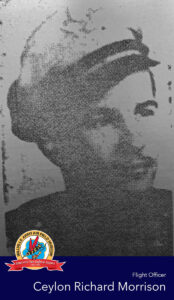 F.O. Morrison, serial number T-192074, was born in Watertown, Jefferson Co., New York, on January 22, 1921. As a young boy, Richard’s hobby was building model airplanes. Being very athletic, he also enjoyed playing all sports extensively. He attended Trott Vocational School and graduated in 1939 where he majored in Chemistry and was the Senior Class President. After graduation he worked as a refinisher; later he was employed by the Hooker Electrochemical Company as a chemical operator until September 22, 1941 when he enlisted in the Royal Canadian Air Force (RCAF) at Vancouver, British Columbia, Canada for the duration of the war.
F.O. Morrison, serial number T-192074, was born in Watertown, Jefferson Co., New York, on January 22, 1921. As a young boy, Richard’s hobby was building model airplanes. Being very athletic, he also enjoyed playing all sports extensively. He attended Trott Vocational School and graduated in 1939 where he majored in Chemistry and was the Senior Class President. After graduation he worked as a refinisher; later he was employed by the Hooker Electrochemical Company as a chemical operator until September 22, 1941 when he enlisted in the Royal Canadian Air Force (RCAF) at Vancouver, British Columbia, Canada for the duration of the war.
His RCAF serial number was AF#R133143. He earned his RCAF Pilot Flying Badge on August 14, 1942 piloting transport planes. A week later on the 22nd, he married Ruth Anita Depew in Niagara Falls, NY. Officially discharged from the RCAF on June 1, 1944 with the rank of sergeant, he was evaluated as a superior pilot and had received the C.V.S.M.
In late 1943 he had transferred to the United States Army Air Corps, First Air Force, Mitchell Field on Long Island, New York. He was rated a pilot on June 2, 1944 with the U.S. Army Air Force. Then in the fall of 1944 found him assigned to the 135th Fighter Squadron at Millville Army Air Field for advanced gunnery training. On the afternoon of December 22, 1944, F.O. Morrison took off for a high altitude aerial gunnery mission in a P-47D-6 Thunderbolt (serial number 42-74849). Shortly after becoming airborne, his engine began trailing a little black smoke. At an altitude of approximately 300 feet. FO Morrison’s P47 started to turn right instead of left as usual. At that point smoke began pouring from the cowling and his engine cut out. Attempting to turn his aircraft around and head back to the airfield two miles away he crashed into Union Lake when his aircraft struck the water, submerged and then exploded. Tragically the crash was fatal to F.O. Ceylon Morrison.
Flight Officer Ceylon Richard Morrison was one month away from turning 24, leaving behind a wife and infant son, Richard J.
Second Lieutenant Lee Lon “Sonny” Pryor, Jr.
2nd Lt. Pryor, O-836019, was born in Calhoun City, Mississippi, on Mar 24, 1921. He attended Columbia Military Academy in Columbia, Tennessee, Mississippi State University, and Delta State University before entering the College of Mortuary Sciences in St. Louis, Missouri, graduating in 1941. Sonny had married Mary Fox in early 1941. In January 1942, after passing the state board he received his embalmer’s license. He then worked in the family business at Pryor Funeral home in Calhoun City.
Entering the Army Air Corp on January 30, 1943, at Keesler Field, Biloxi, Mississippi, 2nd Lt. Pryor then received additional flight training in Nashville, Maxwell Field, and Camp Springs. He received his silver wings and commissioned a Second Lieutenant on Aug 4, 1944 at Napier Field, Alabama. He was assigned to Millville Army Air Field, Millville, New Jersey for advanced gunnery training with the 135th Fighter Squadron in March 1945.
On May 2, 1945, while on a skip bombing training mission, his final training mission, Lt. Pryor’s P47G-15 (serial number 42-25185) Thunderbolt collided in mid-air with another P-47 piloted by 2nd Lt. William Slater. At approximately 2000 feet in a trail formation with good spacing between the Thunderbolts, they were on the turn into the base leg when Lt. Slater’s P-47 collided into Lt. “Sonny” Pryor’s fighter. No parachutes were deployed and both pilots were killed.
Lt. Pryor’s P-47 crashed just east of the Lummis Lakes dam off of Lummistown Road seven miles southwest of Millville. The crashes started a forest fire that took the New Jersey Forest Fire Service almost two hours to extinguished.
2nd Lt. Lee Lon Pryor, Jr. was the only child of Lee and Bessie Pryor. He left a widow Mary and a daughter Frances. Forty years after his death, the city of Millville honored his memory naming Pryor Street at the Millville Executive Airport.
Second Lieutenant John Dunlevy Rumbaugh
2nd Lt. Rumbaugh, O-806734, was born August 30, 1917, in Millersburg, Ohio. He was the son of a doctor. In 1935 he graduated from Millersburg High School, where he played basketball, was a manager on the football team, sang in the Glee Club and was active in the Chess Club. After graduating from Ohio State University, he was employed by the Lima Gro-Cord Sole and Heel Company as a chemist. An avid outdoorsman he loved hunting and fishing, and raised carrier pigeons for many years.
He entered the Army Air Corps in 1942. After basic training he was ordered to Spence Field, Georgia for advanced training where he received his silver wings and was commission a Second Lieutenant on June 30, 1943. He served briefly with the 325th Fighter Squadron at Richmond Army Air Field, Virginia. Lt. Rumbaugh was then assigned on August 9th to the 388th Fighter Squadron, 365th Fighter Group, Millville, New Jersey, for advanced gunnery training in the fall of 1943.
Piloting a P-47D-6 Thunderbolt (serial number 42-74763) on October 18, 1943, 2nd Lt. Rumbaugh was towing the target for an aerial gunnery mission off Atlantic City. He radioed the flight leader saying he had to make an emergency landing and asked for the nearest field. He was directed to Bader Field west of Atlantic City. The flight leader radioed several times to tell him to release the tow-target but communication was lost between the two aircraft. Lt. Rumbaugh lined up his Thunderbolt and leveled off for the landing but the tow-target failed to release and caught on the playground equipment located across the stream of water from the runway. The tow-target tore loose, causing his airplane to pull up sharply; then impact the ground and explode.
Second Lieutenant John Dunlevy Rumbaugh was 26 years old at the time of his fatal accident.
Second Lieutenant William Dennis Slater
2nd Lt. Slater, O-835928, was born June 21, 1917, in Cambridge, Massachusetts. Having graduated from Rindge Technical High School, he took night courses at Massachusetts Institute of Technology, concentrating on mechanical engineering. He was a skilled auto mechanic and automobile race driver before enlisting in the Army Air Force on October 23, 1942. He was first employed at Jordon Marsh Company, and then at the Pratt and Whitney plant in Hartford, Connecticut, when he enlisted into the U.S. Army Air Corps from Boston, Massachusetts.
His primary training was in Americus, Georgia from January to March 1944. He was then ordered to Greenwood, Mississippi for Basic training until May of ’44. After graduating from Basic training it was onto Craig Field in Alabama. He received his silver wings and commissioned a Second Lieutenant on August 4, 1944 at Craig Field, Alabama. Later in April 1945 he was sent to Millville, New Jersey, for advanced pilot gunnery training with the 135th Fighter Squadron.
Just after 5 p.m. on May 2, 1945, flying a P-47G-5 (serial number 42-25129), on the second pass of the skip bombing mission he was in a trail formation with good spacing behind 2nd Lt. Pryor. Approaching the base leg, Lt. Slater’s P-47 collided with Lt. “Sonny” Pryor’s P-47 on the turn into the base leg. The two Thunderbolts collided in mid-air at approximately 2000 feet. No parachutes were used and the crash was fatal to both pilots. The collision happened over Cedarville, seven miles south of the Millville Army Air Field. Lt. Slater crashed in Lummistown Pond, near Lummistown. A forest fire started as a result of the two planes crashing that took the New Jersey Forest Fire Service almost two hours to put out.
2nd Lieutenant William Dennis Slater was 27 years old and the oldest of the fourteen P-47 Thunderbolt pilots who perished during training at the Millville Army Air Field.
Second Lieutenant James Franklin “Tommy” Thompson
2nd Lt. Thompson, O-804072, was born in Portsmouth, Virginia, January 24, 1920. He graduated from Churchland High School in Portsmouth, Virginia. After high school James worked as a clerk for the U.S. Government at the Norfolk Navy Yard, Portsmouth, Virginia. He had earned his pilot license and had been a flight instructor at the Portsmouth Airport before entering the Army Air Force as an aviation cadet in July 1942.
He attended Basic training in Nashville, Tennessee and then Primary training at Shaw Field in Sumter, South Carolina. In March 1943 James was in Advanced training at Spence Field, Moultrie, Georgia. While training at Spence Field, Aviation Cadet James Thompson wrote home telling his parents that the Army had washed out his best friends and of the 18 cadets he spoke of, only 6 were left. On May 28, 1943, James F. Thompson received his silver wings and was commissioned a Second Lieutenant.
In the summer of 1943 he was assigned to the 387th Fighter Squadron, 365th Fighter Group for advanced gunnery training in Millville, New Jersey. Advanced gunnery training was three months long and entailed almost 300 flying hours to become thoroughly familiar with their aircraft. Tommy was a small pilot of about 5′ 6” – 5’ 7” and of slight build. So, he and other like pilots flew with a pillow under their parachute pack and the rudder pedals adjusted fully forward in order to have proper vision. Not an uncommon practice for those of short stature.
Shortly after 10 a.m. on October 23, 1943, 2nd Lt. James “Tommy” Thompson was killed when his P-47D-6 Thunderbolt (serial number 42-74798) crashed while making a strafing run on ground gunnery target #2. After completion of his firing run, as he pulled up from the target at full throttle, his aircraft snapped-rolled over on its back to an inverted position and dove into the ground behind the target, exploding on impact. It was suspected that the prop-wash from the previous plane caused his crash. Although there were many theories on what caused Lt. Thompson to crashed, the actual reason will never be known.
Second Lieutenant Charles Melchoir Weber, Jr.
2nd Lt. Weber, O-705650, was born in Muscatine, Iowa, on January 6, 1923, and lived there until entry into the military service. He attended Muscatine Public Schools where in High School he was known as “Wink”. He very active in high school where he was on the basketball and tennis teams, Chemistry Club, Lettermen’s Club, and the Junior Ad Club. His hobbies were hunting and fishing. After graduating high school, he went on to Muscatine Junior College. He worked in the family’s Weber Cigar Store before enlisting in the Army Air Corps in July 1942 and was called to duty in February 1943.
He received his silver wings and commissioned a Second Lieutenant on January 7, 1944, at Aloe Field, Victoria, Texas. In the spring of 1944, 2nd Lt. Weber was sent for P-47 pilot advanced gunnery training at Millville, New Jersey, with the 536th Fighter Training Squadron.
Piloting a P-47D-2 Thunderbolt (serial number 42-8275) late in the afternoon of May 23, 1944, Lt. Weber took off for a ground gunnery training mission at the Millville gunnery and bombing range (B) near Laurel Lake. He had made four dry passes at the ground target pulling out each time at an altitude of approximately 100 feet. On the 5th pass at the target, Lt. Weber did not fire and proceeded almost straight forward at the target. His P-47 knocked down the target striking the ground in a semi-flat attitude exploding upon impact. A crash truck and ambulance were dispatched to the crash site almost immediately.
The crash was fatal to 21-year-old Second Lieutenant Charles Melchoir Weber, Jr. He was the only child of Charles and Sarah Weber.
